2017 FORD F SERIES MOTORHOME AND COMMERCIAL CHASSIS tire type
[x] Cancel search: tire typePage 116 of 164
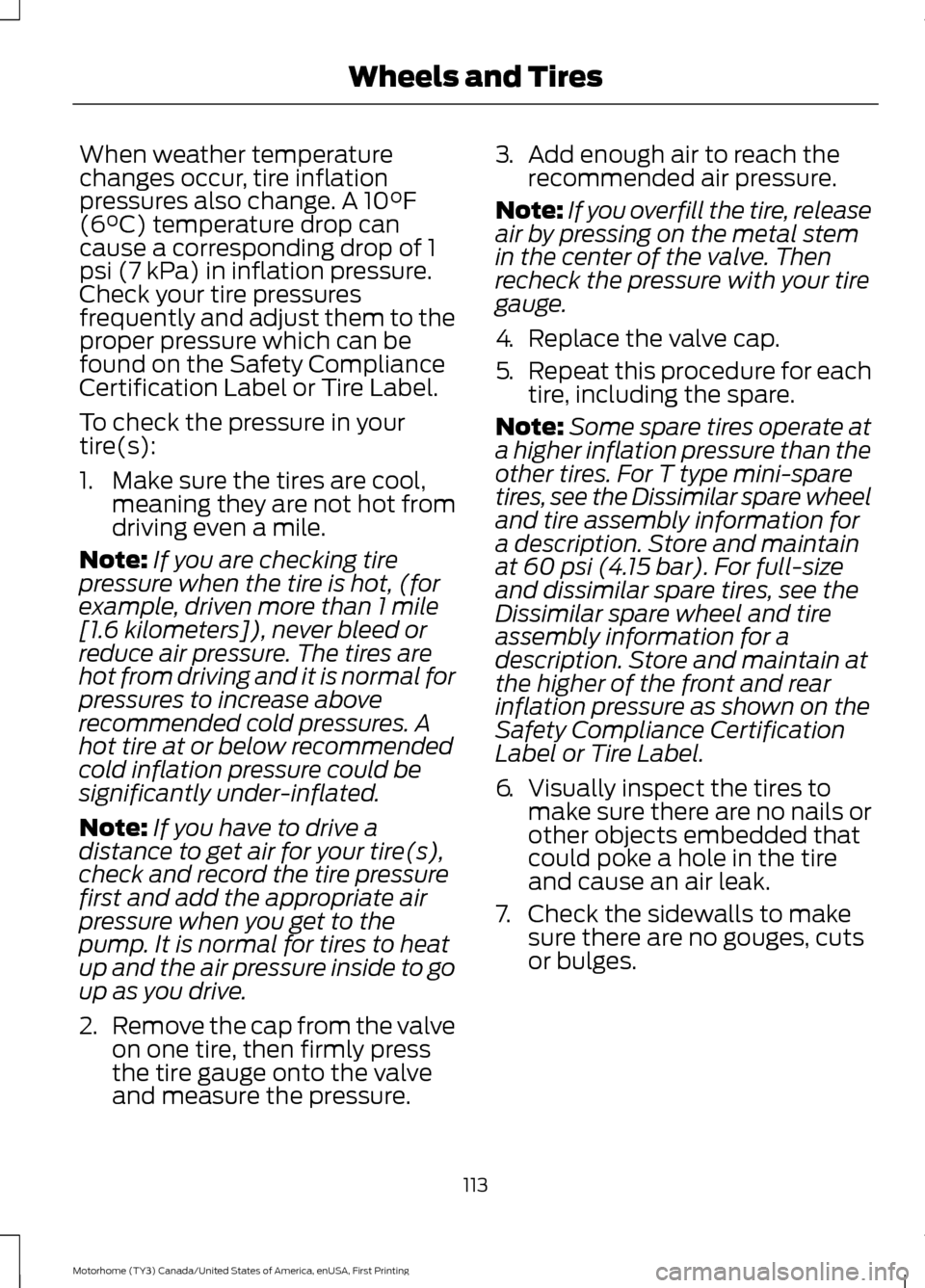
When weather temperature
changes occur, tire inflation
pressures also change. A 10°F
(6°C) temperature drop can
cause a corresponding drop of 1
psi (7 kPa) in inflation pressure.
Check your tire pressures
frequently and adjust them to the
proper pressure which can be
found on the Safety Compliance
Certification Label or Tire Label.
To check the pressure in your
tire(s):
1. Make sure the tires are cool,
meaning they are not hot from
driving even a mile.
Note: If you are checking tire
pressure when the tire is hot, (for
example, driven more than 1 mile
[1.6 kilometers]), never bleed or
reduce air pressure. The tires are
hot from driving and it is normal for
pressures to increase above
recommended cold pressures. A
hot tire at or below recommended
cold inflation pressure could be
significantly under-inflated.
Note: If you have to drive a
distance to get air for your tire(s),
check and record the tire pressure
first and add the appropriate air
pressure when you get to the
pump. It is normal for tires to heat
up and the air pressure inside to go
up as you drive.
2. Remove the cap from the valve
on one tire, then firmly press
the tire gauge onto the valve
and measure the pressure. 3.
Add enough air to reach the
recommended air pressure.
Note: If you overfill the tire, release
air by pressing on the metal stem
in the center of the valve. Then
recheck the pressure with your tire
gauge.
4. Replace the valve cap.
5. Repeat this procedure for each
tire, including the spare.
Note: Some spare tires operate at
a higher inflation pressure than the
other tires. For T type mini-spare
tires, see the Dissimilar spare wheel
and tire assembly information for
a description. Store and maintain
at 60 psi (4.15 bar). For full-size
and dissimilar spare tires, see the
Dissimilar spare wheel and tire
assembly information for a
description. Store and maintain at
the higher of the front and rear
inflation pressure as shown on the
Safety Compliance Certification
Label or Tire Label.
6. Visually inspect the tires to
make sure there are no nails or
other objects embedded that
could poke a hole in the tire
and cause an air leak.
7. Check the sidewalls to make sure there are no gouges, cuts
or bulges.
113
Motorhome (TY3) Canada/United States of America, enUSA, First Printing Wheels and Tires
Page 117 of 164
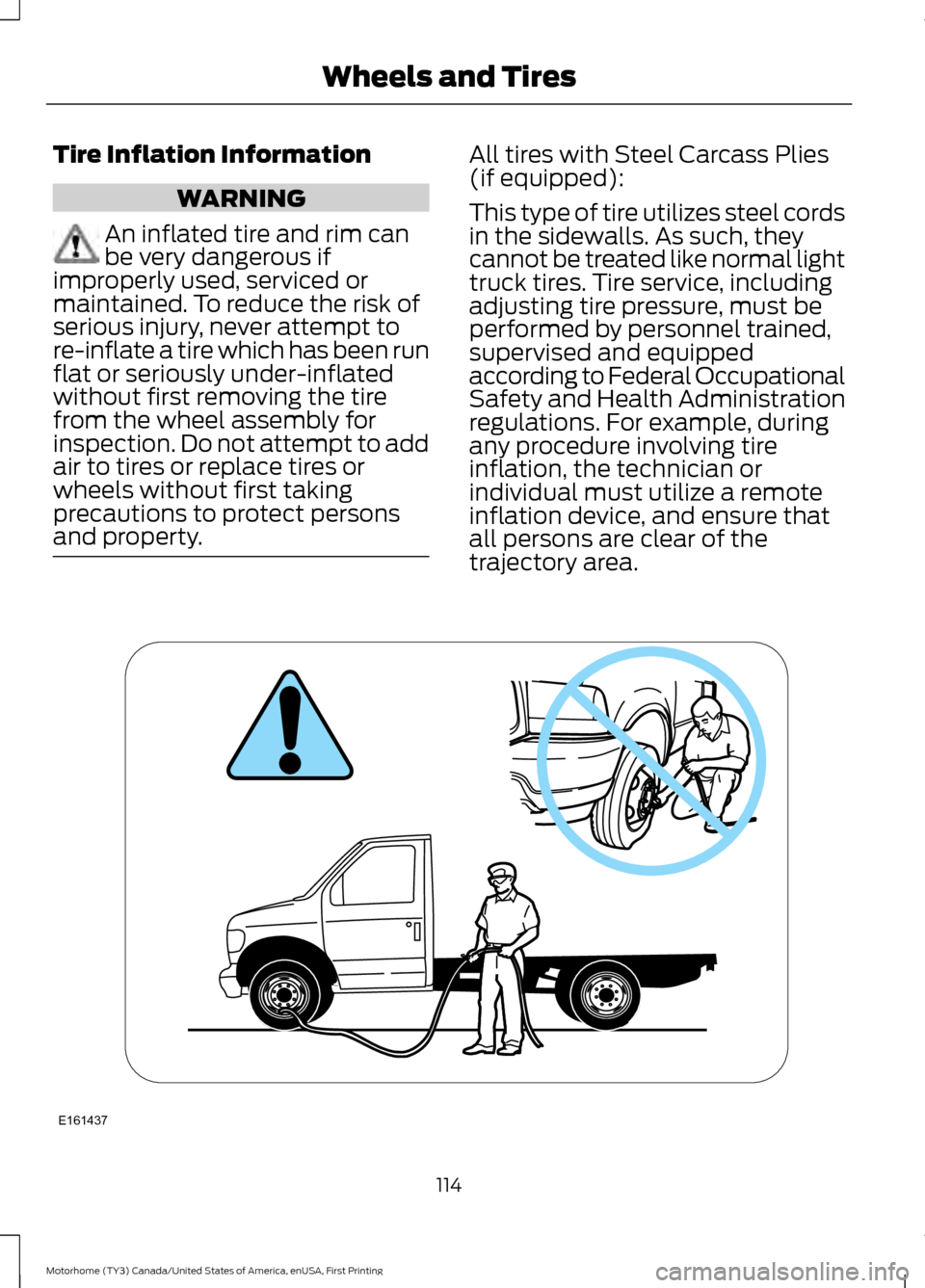
Tire Inflation Information
WARNING
An inflated tire and rim can
be very dangerous if
improperly used, serviced or
maintained. To reduce the risk of
serious injury, never attempt to
re-inflate a tire which has been run
flat or seriously under-inflated
without first removing the tire
from the wheel assembly for
inspection. Do not attempt to add
air to tires or replace tires or
wheels without first taking
precautions to protect persons
and property. All tires with Steel Carcass Plies
(if equipped):
This type of tire utilizes steel cords
in the sidewalls. As such, they
cannot be treated like normal light
truck tires. Tire service, including
adjusting tire pressure, must be
performed by personnel trained,
supervised and equipped
according to Federal Occupational
Safety and Health Administration
regulations. For example, during
any procedure involving tire
inflation, the technician or
individual must utilize a remote
inflation device, and ensure that
all persons are clear of the
trajectory area.
114
Motorhome (TY3) Canada/United States of America, enUSA, First Printing Wheels and TiresE161437
Page 120 of 164
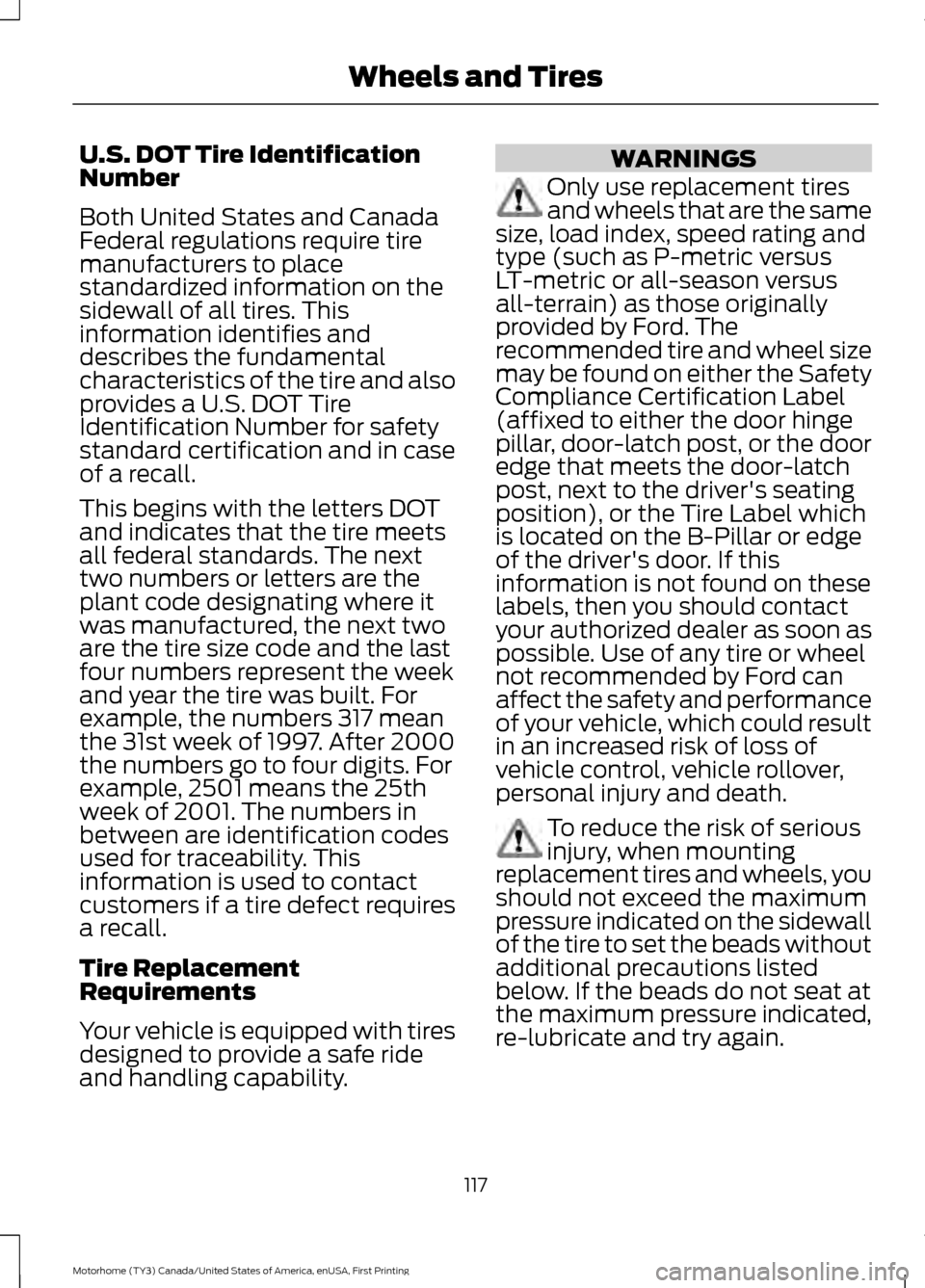
U.S. DOT Tire Identification
Number
Both United States and Canada
Federal regulations require tire
manufacturers to place
standardized information on the
sidewall of all tires. This
information identifies and
describes the fundamental
characteristics of the tire and also
provides a U.S. DOT Tire
Identification Number for safety
standard certification and in case
of a recall.
This begins with the letters DOT
and indicates that the tire meets
all federal standards. The next
two numbers or letters are the
plant code designating where it
was manufactured, the next two
are the tire size code and the last
four numbers represent the week
and year the tire was built. For
example, the numbers 317 mean
the 31st week of 1997. After 2000
the numbers go to four digits. For
example, 2501 means the 25th
week of 2001. The numbers in
between are identification codes
used for traceability. This
information is used to contact
customers if a tire defect requires
a recall.
Tire Replacement
Requirements
Your vehicle is equipped with tires
designed to provide a safe ride
and handling capability.
WARNINGS
Only use replacement tires
and wheels that are the same
size, load index, speed rating and
type (such as P-metric versus
LT-metric or all-season versus
all-terrain) as those originally
provided by Ford. The
recommended tire and wheel size
may be found on either the Safety
Compliance Certification Label
(affixed to either the door hinge
pillar, door-latch post, or the door
edge that meets the door-latch
post, next to the driver's seating
position), or the Tire Label which
is located on the B-Pillar or edge
of the driver's door. If this
information is not found on these
labels, then you should contact
your authorized dealer as soon as
possible. Use of any tire or wheel
not recommended by Ford can
affect the safety and performance
of your vehicle, which could result
in an increased risk of loss of
vehicle control, vehicle rollover,
personal injury and death. To reduce the risk of serious
injury, when mounting
replacement tires and wheels, you
should not exceed the maximum
pressure indicated on the sidewall
of the tire to set the beads without
additional precautions listed
below. If the beads do not seat at
the maximum pressure indicated,
re-lubricate and try again.
117
Motorhome (TY3) Canada/United States of America, enUSA, First Printing Wheels and Tires
Page 124 of 164
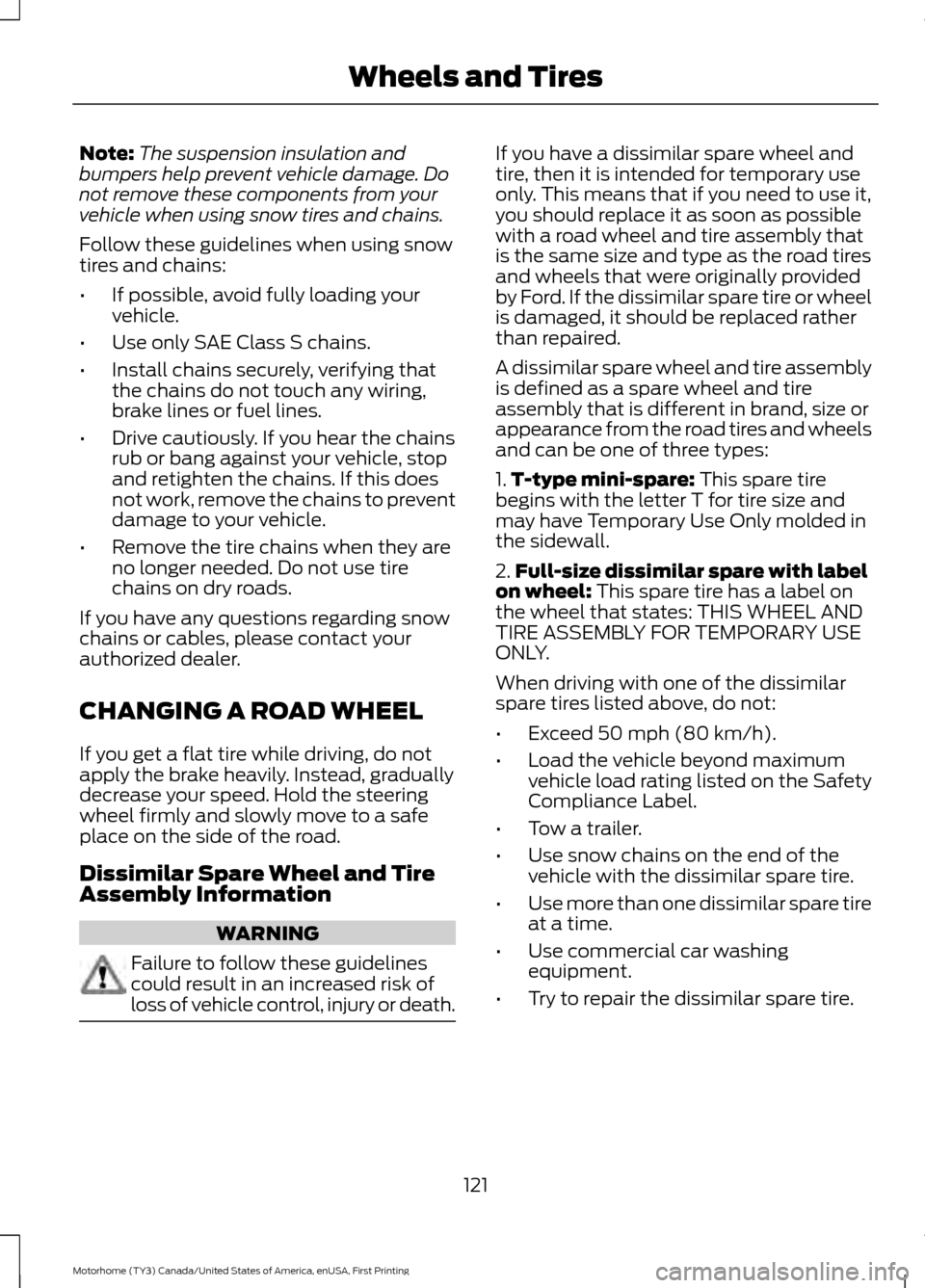
Note:
The suspension insulation and
bumpers help prevent vehicle damage. Do
not remove these components from your
vehicle when using snow tires and chains.
Follow these guidelines when using snow
tires and chains:
• If possible, avoid fully loading your
vehicle.
• Use only SAE Class S chains.
• Install chains securely, verifying that
the chains do not touch any wiring,
brake lines or fuel lines.
• Drive cautiously. If you hear the chains
rub or bang against your vehicle, stop
and retighten the chains. If this does
not work, remove the chains to prevent
damage to your vehicle.
• Remove the tire chains when they are
no longer needed. Do not use tire
chains on dry roads.
If you have any questions regarding snow
chains or cables, please contact your
authorized dealer.
CHANGING A ROAD WHEEL
If you get a flat tire while driving, do not
apply the brake heavily. Instead, gradually
decrease your speed. Hold the steering
wheel firmly and slowly move to a safe
place on the side of the road.
Dissimilar Spare Wheel and Tire
Assembly Information WARNING
Failure to follow these guidelines
could result in an increased risk of
loss of vehicle control, injury or death. If you have a dissimilar spare wheel and
tire, then it is intended for temporary use
only. This means that if you need to use it,
you should replace it as soon as possible
with a road wheel and tire assembly that
is the same size and type as the road tires
and wheels that were originally provided
by Ford. If the dissimilar spare tire or wheel
is damaged, it should be replaced rather
than repaired.
A dissimilar spare wheel and tire assembly
is defined as a spare wheel and tire
assembly that is different in brand, size or
appearance from the road tires and wheels
and can be one of three types:
1.
T-type mini-spare: This spare tire
begins with the letter T for tire size and
may have Temporary Use Only molded in
the sidewall.
2. Full-size dissimilar spare with label
on wheel:
This spare tire has a label on
the wheel that states: THIS WHEEL AND
TIRE ASSEMBLY FOR TEMPORARY USE
ONLY.
When driving with one of the dissimilar
spare tires listed above, do not:
• Exceed
50 mph (80 km/h).
• Load the vehicle beyond maximum
vehicle load rating listed on the Safety
Compliance Label.
• Tow a trailer.
• Use snow chains on the end of the
vehicle with the dissimilar spare tire.
• Use more than one dissimilar spare tire
at a time.
• Use commercial car washing
equipment.
• Try to repair the dissimilar spare tire.
121
Motorhome (TY3) Canada/United States of America, enUSA, First Printing Wheels and Tires
Page 157 of 164
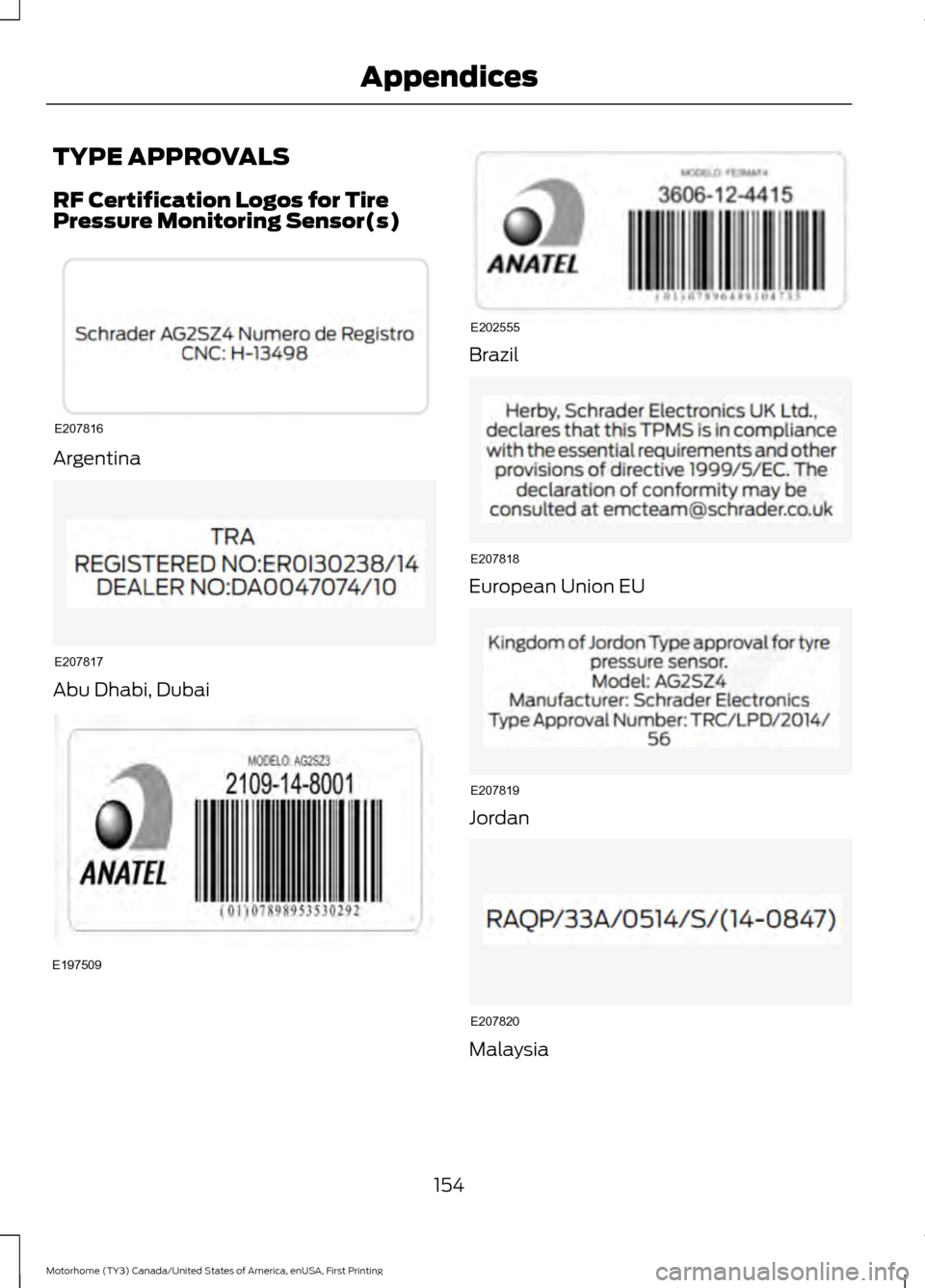
TYPE APPROVALS
RF Certification Logos for Tire
Pressure Monitoring Sensor(s)
Argentina
Abu Dhabi, Dubai Brazil
European Union EU
Jordan
Malaysia
154
Motorhome (TY3) Canada/United States of America, enUSA, First Printing AppendicesE207816 E207817 E197509 E202555 E207818 E207819 E207820
Page 163 of 164

Speed Control
See: Cruise Control.............................................. 38
Starter Switch See: Ignition Switch............................................. 23
Starting a Gasoline Engine.........................23 Failure to Start....................................................... 24
Guarding Against Exhaust Fumes.................24
Important Ventilating Information................24
Stopping the Engine When Your Vehicle is Moving................................................................. 24
Stopping the Engine When Your Vehicle is Stationary........................................................... 24
Starting and Stopping the Engine............23 General Information............................................ 23
Steering Wheel................................................10
Symbols Glossary.............................................3
T
Technical Specifications See: Capacities and Specifications.............125
The Better Business Bureau (BBB) Auto Line Program (U.S. Only).........................60
Tire Care
...........................................................105
Glossary of Tire Terminology......................... 106
Information About Uniform Tire Quality Grading.............................................................. 105
Information Contained on the Tire Sidewall............................................................. 107
Temperature A B C............................................ 106
Traction AA A B C............................................... 105
Treadwear............................................................. 105
Tires See: Wheels and Tires...................................... 105
Towing a Trailer...............................................45 Load Placement................................................... 45
Towing the Vehicle on Four Wheels.......50 Emergency Towing.............................................. 50
Towing................................................................45
Transmission Code Designation.............128
Transmission....................................................33
Transmission See: Transmission................................................ 33
Transporting the Vehicle
.............................56
Type Approvals.............................................154
RF Certification Logos for Tire Pressure
Monitoring Sensor(s)................................... 154U
Under Hood Overview - Commercial
Chassis............................................................86
Under Hood Overview - Motorhome Chassis............................................................87
Using Cruise Control.....................................38 Switching Cruise Control Off........................... 38
Switching Cruise Control On............................ 38
Using Snow Chains
......................................120
Utilizing the Mediation/Arbitration Program (Canada Only)............................61
V
Vehicle Care.....................................................101 General Information........................................... 101
Vehicle Certification Label.........................127
Vehicle Identification Number
.................127
Vehicle Storage.............................................103 Battery.................................................................... 103
Body........................................................................\
103
Brakes..................................................................... 104
Cooling system.................................................... 103
Engine..................................................................... 103
Fuel system.......................................................... 103
General................................................................... 103
Miscellaneous...................................................... 104
Removing Vehicle From Storage.................. 104
Tires........................................................................\
. 104
VIN See: Vehicle Identification Number..............127
W
Warning Lamps and Indicators..................16 Anti-Lock Braking System................................. 16
Battery....................................................................... 16
Brake Reserve System......................................... 17
Brake System.......................................................... 17
Cruise Control.......................................................... 17
Direction Indicator................................................. 17
Electronic Throttle Control................................. 17
Fasten Safety Belt................................................. 17
High Beam................................................................ 17
Service Engine Soon............................................. 17
Transmission Tow/Haul...................................... 18
160
Motorhome (TY3) Canada/United States of America, enUSA, First Printing Index